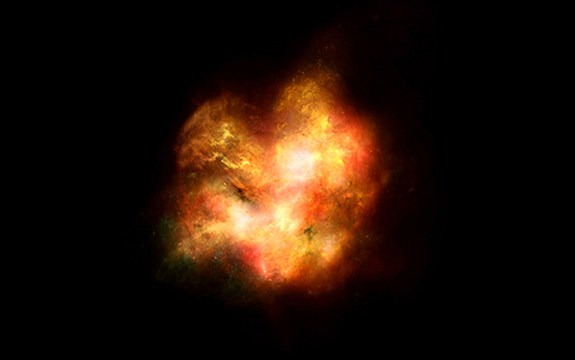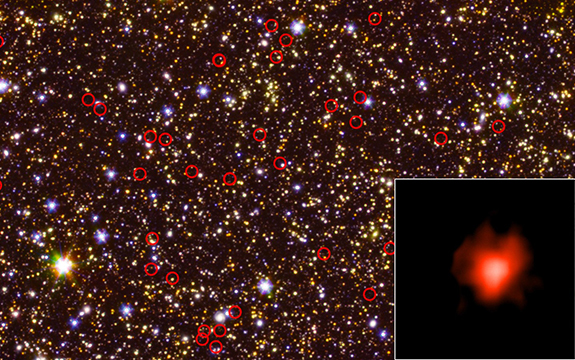
An artist’s impression of what the first galaxies in the Universe may have looked like shows violent star formation and star death illuminating the gas between stars, making the galaxy largely opaque.
In summary
- Study using NASA’s Spitzer Space Telescope shows ancient galaxies were brighter than expected
- Archival data from NASA’s Hubble Space Telescope also used
- Study is published in the Monthly Notices of the Royal Astronomical Society
NASA’s Spitzer Space Telescope has revealed that our some of the earliest galaxies formed after the Big Bang were brighter than we thought. This extra light comes from the hot young stars being created in the galaxies and is thought to play an important role in transforming our Universe from being mostly opaque to the star-filled cosmos we see today.
In a new study, researchers – including Swinburne’s Associate Professor Ivo Labbé – report on observations of some of the first galaxies to form in the Universe, less than one billion years after the Big Bang (or a little more than 13 billion years ago).
The data shows that in a few specific wavelengths of infrared light, the galaxies are considerably brighter than scientists had expected.
The study is the first to confirm this fact for a large sampling of galaxies from this period, showing that these were not special cases of excessive brightness, but that even average galaxies present at that time were much brighter in these wavelengths than galaxies we see today.
“We discovered that galaxies in the early Universe were very different from today. In fact, the typical galaxy way-back-when is so extreme that there are almost no similar galaxies in the entire nearby Universe,” Associate Professor Labbé says.
“The young galaxies are bursting with powerful radiation lighting up their gas, which started glowing as bright as the stars themselves at some infrared wavelengths.”
No one knows for sure when the first stars in our Universe burst to life. Evidence suggests that between about 100 million and 200 million years after the Big Bang, the Universe was filled mostly with neutral hydrogen gas that had begun to coalesce into stars, which then began to form the first galaxies.
By about one billion years after the Big Bang, the Universe had become a sparkling firmament.
Something else had changed, too: the electrons of the omnipresent neutral hydrogen gas had been stripped away, in a process known as ionisation. The Epoch of Reionisation — the change-over from a Universe full of neutral hydrogen, to one filled with ionised hydrogen — is well documented.
Before this Universe-wide transformation took place, long-wavelength forms of light, such as radio waves and visible light, traversed the Universe more or less unencumbered. Shorter wavelengths of light — including ultraviolet light, X-rays and gamma rays — were stopped short by neutral hydrogen atoms. At the same time, these collisions would strip those neutral hydrogen atoms of their electrons, ionising them.
What could have possibly produced enough ionising radiation to affect all the hydrogen in the Universe? Was it individual stars? Giant galaxies? If either of these is responsible, those early cosmic colonisers would have been different than most modern stars and galaxies, which typically don’t release high amounts of ionising radiation. Then again, perhaps the event was caused by something else entirely, such as quasars — galaxies with incredibly bright centres powered by huge amounts of material orbiting around supermassive black holes.
“It’s one of the biggest open questions in observational cosmology,” says Stephane de Barros, lead author of the study and a postdoctoral researcher at the University of Geneva in Switzerland. “We know it happened, but what caused it? These new findings could be a big clue.”
Looking for light
To peer back in time to the era just before the Epoch of Reionisation ended, Spitzer stared at two regions of the sky for more than 200 hours each, allowing the space telescope to collect light that had travelled for more than 13 billion years to reach us. These are some of the longest science observations ever carried out by Spitzer.
The , published in the Monthly Notices of the Royal Astronomical Society, also used archival data from NASA’s Hubble Space Telescope.
 This deep-field view of the sky taken by NASA’s Hubble and Spitzer space telescopes is dominated by galaxies — including some very faint, very distant ones — circled in red. The bottom right inset shows the light collected from one of those galaxies during a long-duration observation. Credit: NASA/JPL-Caltech/ESA/Spitzer/P Oesch/S De Barros
This deep-field view of the sky taken by NASA’s Hubble and Spitzer space telescopes is dominated by galaxies — including some very faint, very distant ones — circled in red. The bottom right inset shows the light collected from one of those galaxies during a long-duration observation. Credit: NASA/JPL-Caltech/ESA/Spitzer/P Oesch/S De Barros
Using these ultra-deep observations by Spitzer, astronomers observed 135 distant galaxies and found that they were all particularly bright in two specific wavelengths of infrared light produced by ionising radiation interacting with hydrogen and oxygen gases within the galaxies. This implies that these galaxies were dominated by young, massive stars composed mostly of hydrogen and helium.
They contain very small amounts of ‘heavy’ elements (like nitrogen, carbon and oxygen) compared to stars found in average modern galaxies. This implies that they were not the very first stars to form in the Universe (those would have been composed of hydrogen and helium only), but were still members of a very early generation of stars.
The Epoch of Reionisation was not an instantaneous event, so while the new results are not enough to close the book on this cosmic event, they do provide new details about how the Universe evolved at this time, and how the transition played out.
NASA’s James Webb Space Telescope will study the Universe in many of the same wavelengths currently observed by Spitzer. But where Spitzer’s primary mirror is only 85 centimetres in diameter, Webb’s primary mirror is 6.5 metres, or about 7.5 times larger. It will be able to study these galaxies in much more detail. The new study shows that due to their brightness in those infrared wavelengths, these galaxies will be much easier for Webb to study than previously thought.






